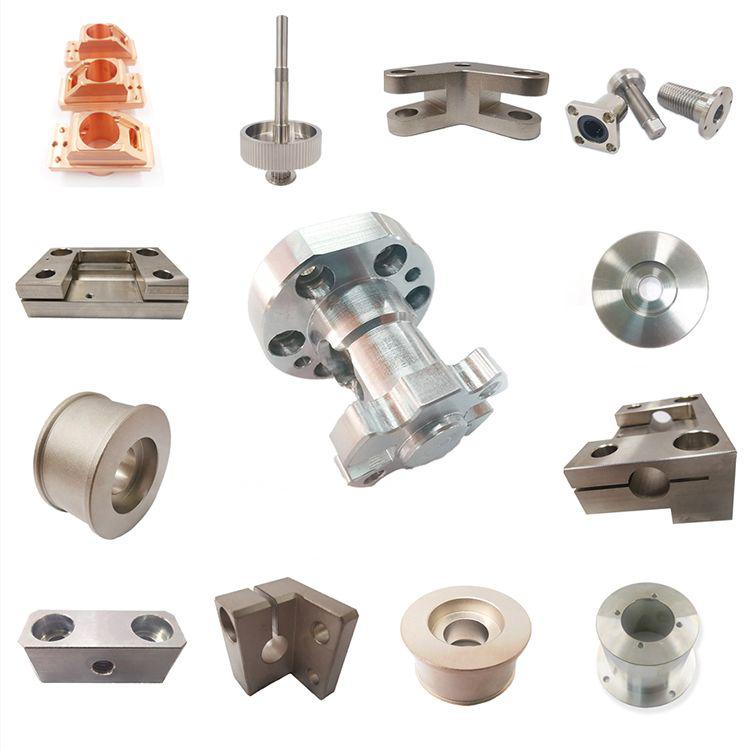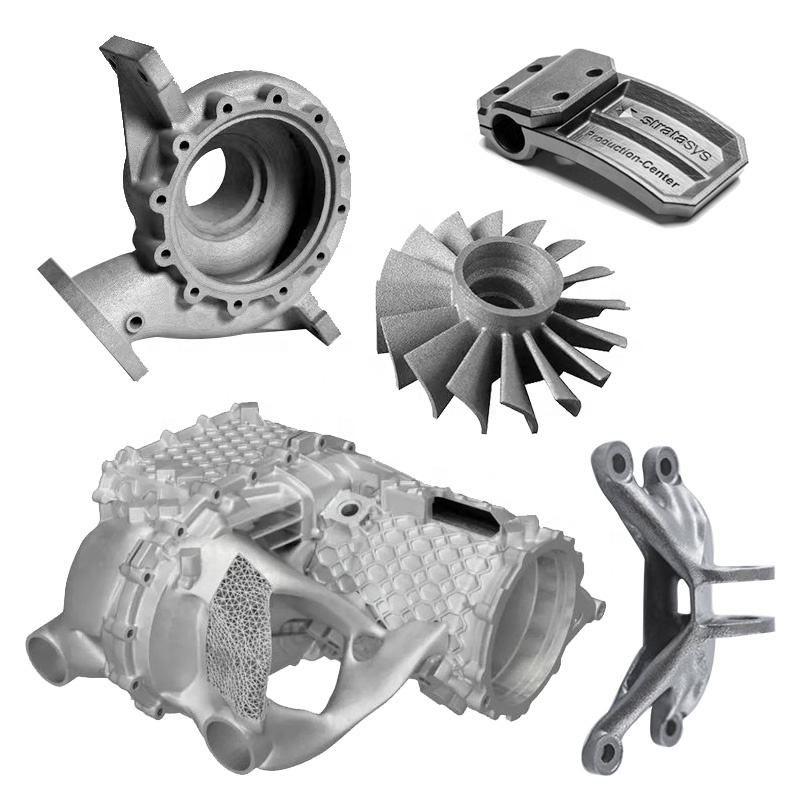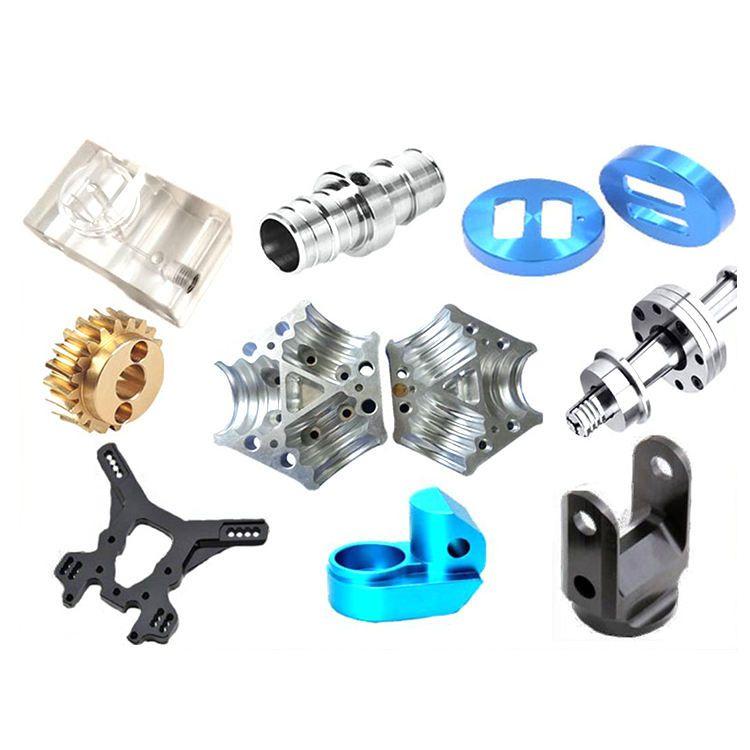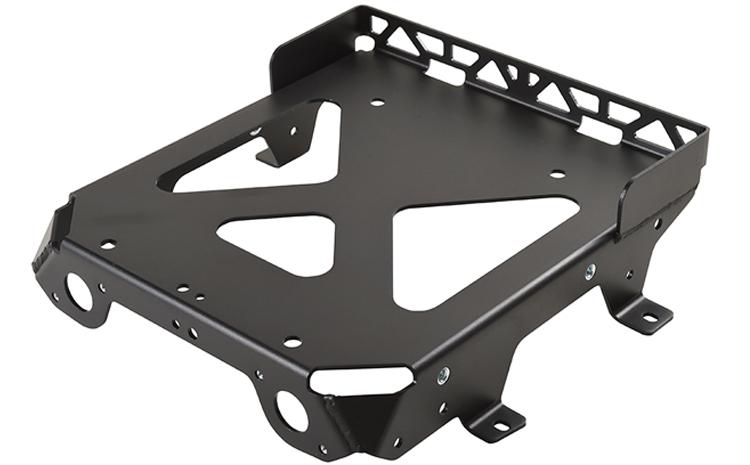
Metal parts are unique to each industry and application. Engineers and designers need to understand the parts' materials, manufacturing processes, and use cases to determine the appropriate method to create them. Let's look at the method of Custom metal parts manufacturing. Asset metal:
How metal parts are manufactured can vary widely. Each process has its own advantages, compatible material trade-offs. A better understanding of the range of production methods will improve this decision-making process. This is an overview of 8 different manufacturing processes that can be used to create custom metal parts. these are:
CNC Milling and CNC Turning
extrusion
metal casting
die casting
metal injection molding
forging
Sheet Metal and Stamping
Metal 3D Printing

1. CNC turning and milling
There are two main types of CNC machining technology. CNC milling machines are automatic cutting machines. They use rotating spindle heads to cut off unwanted material. Turning rotates the material against the stationary tool to remove the material into the desired shape. They are suitable for a variety of materials, including plastic, aluminum, stainless steel and titanium.
How CNC Machining and Turning Work
CNC turning involves the use of a CNC lathe or a multi-axis CNC turning center. Manufacturers use CNC lathes to turn material for cylindrical and concentric features on parts. Power lathes combine end mills and drills to produce off-axis features without changing platforms. Specialized CNC lathes, commonly referred to as Swiss machines, are designed to rapidly produce small parts with complex features by combining multiple tools and spindles within the machine.
A typical lathe will rotate the part on a central axis to remove features by engaging a rigid cutting tool. Other functions performed by the lathe include creating internal and external threads, creating flange features, O-ring grooves, and knurling textures.
CNC lathes and CNC mills have different axis configurations. CNC lathes are usually 3- or 4-axis machines with a single spindle. 3-axis CNC machining processes material in the X, Y and Z axes, removing shavings in all three directions. 4-axis tools combine motion beyond lathe concentric features and mill tilt. Lathes are ideal for round parts and operate more intensively for irregular shapes and sharp edges, while milling machines are the opposite.
More modern CNC technology supports up to 5 axes. These tools add tilt and rotation to the traditional X, Y, and Z axes, allowing precise cuts on more detailed parts. 5-axis machining is also more efficient because it creates more part features in one operation. Milling machines come in a variety of configurations, typically 3, 4, and 5 axes.
CNC stands for Computer Numerical Control, and operators control CNC mills and lathes using G-code, a programming language that provides instructions for machine movements. Modern programming instructions are created with computer-aided manufacturing (CAM) software. This code tells the machine where to move the cutter head. It also controls its speed and feed, i.e. rotation, depth of cut and workpiece movement. The complexity of the G-code depends on the number of axes of the machine and the toolset used.
2. Squeeze
Extrusion involves pushing heated metal or plastic through a die. In practice, it is similar to squeezing a tube of toothpaste. Molds create net shapes such as tubes, L structures, or more complex features. Extrusion of metal parts often requires post-processing such as cutting, drilling or machining. It is ideal for large numbers of parts that require a constant cross section.
This is because extruded profiles can be of almost any shape with a continuous cross-section. A good example is window frames, which have multiple functions to hold different panes in components. They can even be hollow, such as square, round or hexagonal tubes. Manufacturers determine the shape of a mold when it creates it.
How extrusion works
The three types of extrusion are hot extrusion, cold extrusion and friction. Hot extrusion involves high temperatures to prevent hardening of the working material. Cold extrusion involves close to room temperature, which provides some advantages over hot extrusion. The material may be stronger, less oxidized or have tighter tolerances. Finally, friction extrusion involves the use of force to push the charge towards the die.
Extruded material
The extruded material can be plastic or metal. About 80% of extruded metal components are aluminum alloys. Meanwhile, polyethylene is most common in plastic extrusion.
Use Cases and Industries
Extrusion is a simple process compared to other methods. Its tooling cost is 80% to 90% lower than injection molding and die casting. Extrusion also provides a smoother surface for paints and finishes. This makes extrusion ideal for precision and decorative parts. Floors, windows and railings are ideal applications. Automotive and aerospace components are also ideal for extrusion.

3. Metal casting
Metal casting is a time-honored manufacturing process. It involves pouring liquid metal into a mold. The liquid metal hardens into the desired shape. It is then cooled and removed from the mold.
Modern metal casting is precise, automated, and uses advanced tools. But the principle remains the same. Its widespread use is testament to the success of this approach.
how does this work
The metal casting process begins with molding. The pattern creates partially shaped voids in the mold before the liquid metal is poured. Modern plate making methods use precise calculations to achieve the desired shape. This can include scaling to account for shrinkage and preparing excess material thickness for later CNC finishing.
In many cases, the mold was destroyed during the casting process. This is a planning step when sand casting, where the casting formed from the sand is broken down to reveal the finished product. New sand casting molds are easy to make, and sand is often recycled to make new molds.
Metal casting may also involve the use of wax in a process called investment casting. Manufacturers first build a wax model of the final product. Before the wax is heated and removed, the wax is covered with a ceramic layer. A ceramic moulding mould with a pattern moulded from wax printed on the inside.
There are benefits to each of these two techniques. For example, sand casting is a simpler process and easy to repeat. Investment casting requires more preparation, but may perform better when creating complex parts. Sand casting generally costs more; investment casting requires more labor to change a given design. Manufacturers must determine the best process based on their budget and labor constraints and the quality of the part they want.
metal casting material
Metal casting is a general process. It supports any metal parts that can achieve liquid form. This is why engineers from all walks of life use a variety of materials in metal casting. Aluminum, magnesium and copper alloys are the most common alloys. But manufacturers also use zinc, steel and other metals.
Foundry use cases and industries
Almost all commercially produced mechanical equipment today uses some form of casting. In mass production, casting generally outperforms CNC machining in terms of cost and yield. Metal casting enables high-tolerance structural components for a variety of use cases. Washing machines, cars, metal pipes all use metal castings.
4. Die casting
Die casting is ideal for high volume complex metal parts. Die casting uses steel molds and low melting point metals as materials. Engineers use die casting for complex projects where precision, reliability, and production-level throughput are critical. Die casting uses a hard, reusable tool similar to the injection molding process, resulting in a smoother surface finish on the part while keeping high volume low cost.
how does this work
In die casting, liquid metal is forced into the mold by high hydraulic or pneumatic pressure. This is different from traditional metal casting where metal is poured. Manufacturers prefer die casting when making parts with intricate details. Use pressure to create intricate things more effectively.
Hot chamber or "gooseneck" die casting is the most popular method. A "gooseneck" describes the shape of the metal feed system that delivers molten metal to the die. Manufacturers use cold chamber die casting to limit machine corrosion. This method involves pouring molten metal into an injection system. In each of these methods, the process is similar to plastic injection molding, where the steel tool is closed and the part material flows into the mold cavity to harden the part's form. Once hardened, the tool opens and the part is either dropped mechanically or removed manually.
Die casting material
Die casting manufacturers often specialize in individual materials, including aluminum, zinc or magnesium. This is because the raw material is molten metal juxtaposed with a dedicated die casting machine. About 80% of die castings are made of aluminum. Zinc alloy is another low melting point metal and a commonly used material in die casting.
Use Cases and Industries-Custom metal parts manufacturing
Die-cast parts are widely used. They are strong and heat resistant. They also have smooth or textured surfaces. Die casting is good for high throughput and can often outperform CNC and investment casting. This supports a wide range of paints, platings and finishes. Nonetheless, die casting is ideal for use with high-impact, high-stress equipment where strength is critical.

5. Metal Injection Molding
Injection molding is most commonly used to make plastic parts. But manufacturers also use injection molding services for metal parts. It is cost-effective even for large-scale projects with high precision. While it's perfect for projects that require small parts, Metal Injection Molding or MIM can be used for parts of any size.
how does this work-Custom metal parts manufacturing
Unlike die casting, metal injection molding uses a feed of a polymer-metal mixture, where molten plastic allows the material to flow when heated. During this process, the material is also pressurized. The machine injects the liquid material into the mold. The material cools and takes the form of a mold to make the part.
After molding, the parts are in a "green state", which means they are in the correct shape but very fragile. The post-sintering process completely ablates the plastic, leaving only molten metal. During this furnace process, usually done in a vacuum furnace, the part shrinks by a considerable amount.
MIM material-Custom metal parts manufacturing
Metal injection molding can be used with metals common to other manufacturing processes. However, the process requires these metals to be powdered and mixed with polymers for injection. In this way, parts can be rapidly prototyped and produced in large quantities.
Use Cases and Industries-Asset metal
Metal injection molding is similar to the plastic injection molding process used to make parts. But the high-pressure nature of injection molding adds key advantages. It works well for parts with small and intricate details. This is too costly for large-scale standard CNC machining processes. That's why metal injection molding is ideal for the medical, aerospace, automotive and defense industries
Compared to die casting and other metal fabrication methods, injection molds last longer, allowing for a greater number of parts before replacement or maintenance. In mass production or where finer part detail is required, MIM often outperforms die casting. This makes it suitable for large-scale repetitive processes. It also offers manufacturers more flexibility in terms of strength and unique properties.
6. Forging
Like metal casting, forging has been used for centuries. It is the process of forcibly heating and forming metal parts. The familiar images of the blacksmith and the anvil come to mind. Today, forging is widely used to automate industrial processes.
how does this work-Asset metal
Modern forging uses high-impact machines to shape the metal into the desired result. Forging produces less waste than other methods, which makes it more cost-effective in practical applications.
Forged parts are generally stronger than parts made by other methods. That's because forging takes advantage of the natural texture of its material. When formed in a forging, the material does not need to be reduced to a liquid, just heated to a malleable state.
forging material
Stainless steel is one of the most common forged materials. Aluminum and bronze are also common forging materials.
Use Cases and Industries
Forging is ideal for many industries. Its strengths and limitations make it an ideal process for use with other manufacturing materials. Forged tools, such as hammers or wrenches, are common examples of lifetime parts made using this method. Manufacturers should identify use cases where forging benefits contribute to better business and production results.

7. Sheet metal and stamping
Sheet metal fabrication involves cutting parts from sheet metal. The blanked sheet can then be machined by means of brakes and die presses to create angled bends and shapes to build 3-dimensional structures. Sheet metal services feature metal stamping to quickly produce these parts. In fact, stamping is faster than any other metalworking process.
how does this work
Stamping machines cut and bend parts from sheet metal. Workers provide cutting or coils of sheet metal for punching machines. The machine straightens the metal as it feeds it into the press. The strategic application of force enables manufacturers to adjust the shape of the part. Bending applies a force at an angle, for example, to create a desired angle in a part. Manufacturers use press brakes in this process, and they are available in different sizes and lengths to suit the manufacturer's needs. Sheet metal parts can be welded or riveted to create structural elements. Press-fit inserts such as PEM inserts allow the addition of mating features such as bosses, threads, and more without the need for custom machining.
sheet metal material
Sheet metal is usually made of aluminum, copper or steel. Sheet metal also comes in a variety of finishes. This includes anodizing, electroplating, powder coating and painting.
Use Cases and Industries
Stamping makes sheet metal fabrication highly scalable in any industry. It is ideal for high volume and low unit cost. High-volume functional components such as housings, chassis, and brackets are often made of sheet metal.
But the die cost of stamping is usually higher than other processes. Still, manufacturers make hundreds of millions of parts every year in the appliance, electronics and automotive industries. Sheet metal and stamping are the best options for robotics.

Asset Metal technology company is a focusing on CNC machining, metal stamping, metal(chemical) etching and surface treatment of OEM/ODM metal parts Processing.


 +8613538580966
+8613538580966

